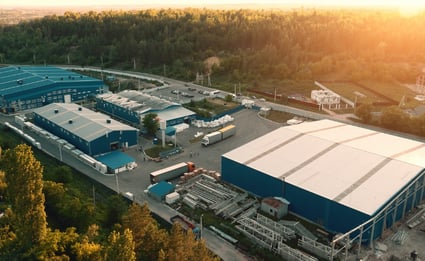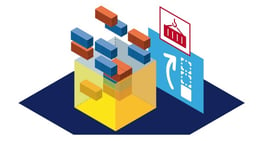5 Interesting Facts About Demand Capacity Planning
Brian Hoey - March 19, 2019

Real supply chains have curves. Demand and capacity curves, to be specific. The goal of every supply chain and production manager out there is to constantly take whatever steps are necessary to match these two curves as closely as possible. If there’s a spike in demand, that means finding a way to increase capacity; if there’s an overabundance of capacity, that means taking steps to drum up demand. This is, essentially, the goal of demand capacity planning workflows in modern supply chain management. As anyone in the industry can attest, this is much easier said than done.
In the spirit of shedding light on such a crucial part of modern SCM, here are a few facts about demand capacity planning that you might not know!
1. Demand Capacity Planning Can Stave Off Some of the Most Common Disruptions
We hinted at this fact a little bit above, but let’s dig deeper into the specifics. In modern manufacturing and logistics, about a third of slowdowns are related to capacity management. Production planners either try to overdeliver their actual capacity levels to meet demand and wind up overusing their machinery and causing production slowdowns in the process, or they simply can’t determine their actual maximum capacity. In this latter case, planners may be under-promising just as often as they’re overextending their capacity. By adopting a demand capacity planning flow that actually determines maximum capacity levels for different circumstances and matches them to changing demand levels, you can stave off these moments of mismatched expectations. Thus, your production lines operate much closer to maximum efficiency, and you can square customer expectations with actual production realities.
2. It Can Also Increase Production Visibility at the Parts Level
Let’s back up a second. We mentioned determining your actual maximum capacity levels, but how does this happen in practice? Essentially, planners have to consider their production workflows for each product that they produce—what’s the limiting factor in terms of production? Is your output limited by the processing speed of your slowest machine or process, or are you limited by sourcing restrictions? Ultimately, you’ll have to combine the different capacity data for each production flow to determine what ratio of what volume of products you can actually produce in a given time period. This will involve putting in some work, but the benefits can go beyond clarifying the nature of the demand-capacity curve. To wit, achieving this level of insight into your production flows can help you to gain a comprehensive understanding of the journey that each part takes through your production facility; thus, you can plan for every part, and earn a previously unattainable level of production control in the process. Yes, this will help you to better adapt to emerging demand, but it can also help you to uncover process improvements that will create new sources of value and new efficiencies going forward.
3. Advanced Analytics and Big Data Can Improve Demand Management
Speaking of uncovering new efficiencies: part of demand capacity planning boils down to simply gaining the visibility necessary to understand the relationship between your actual production capacity and your demand—but beyond that lies new frontiers of potential added value. Specifically, if you’re collecting and storing enough operational data to empower them, advanced predictive and prescriptive analytics processes can bring your demand planning to next level. On one side of the equation, advanced predictive algorithms can help you to generate better demand forecasts, thereby giving you advanced warning for situations in which you might need to find ways to expand your capacity (with appropriate consideration given to the relative costs and benefits of doing so). On the other, you can leverage a digital twin of your production operations to uncover potential process improvements, whether that takes the form of adjusting a supplier relationship, making changes to factory floor layouts, or considering the cost-benefit ratio of upgrading existing equipment. Previously, this level of digital visibility would have been hard to come by, but if you’re able to plan for every part then you should be able to make this level of analytics integration a reality.
4. Demand Capacity Planning Doesn’t Stop at the End of the Production Line
So far, we’ve spoken of this process largely in terms of production flows, but in point of fact the same calculations can be applied to logistics and transport flows just as easily. Instead of seeking out bottlenecks in your factory floor operations, you can determine your maximum output in terms of outbound goods. If you’re a transport planner administering a network, this will be largely the same process (with largely the same value add) that we described above. The total number of trucks and drivers you have, combined with information about particular trade routes and last mile strategies, will give you a rough accounting of your shipping capacity. To gain a more accurate idea, you may need to analyze your value chain digitally, posing hypothetical shipping scenarios to arrive at likely outcomes. If, conversely, you’re using a 3PL, the calculation will be slightly different. You’ll need to forecast your transport needs ahead of time in order to determine how much freight capacity to reserve and what the optimal price at which to reserve it is. Again, this is something that can be done more easily with advanced analytics and big data integration.
5. And It’s a Perfect Fit For Industry 4.0 Environments
Of course, all this talk of digitization and big data analytics might remind of you of another important concept in modern supply chain management. That’s right, we’re talking about Industry 4.0. In point of fact, demand capacity planning in the modern, digital supply chain is actually very closely related to Industry 4.0. Why? Because both are increasingly dependent on digital workflows that map out existing physical processes, and both thrive on the kind of analytics integration that we’ve been describing above. In this way, you can see demand capacity planning as a perfect fit for Industry 4.0 supply chains: with each one you can turn data collected from across the value chain into smarter decision-making, adding value in the form of improved visibility and production control.
If you want to learn more get your Guide to Industry 4.0:
LATEST POSTS
- Understand Circular Economy in The Manufacturing Industry
- How Can Industry 4.0 IT Integration Be Achieved Smoothly?
- The Significance of Order Sequencing in Discrete Manufacturing
- How to improve your Supply Chain Management: The Power of Control Towers
- Optimizing Human Resource Scheduling in Manufacturing: A Technological Approach



